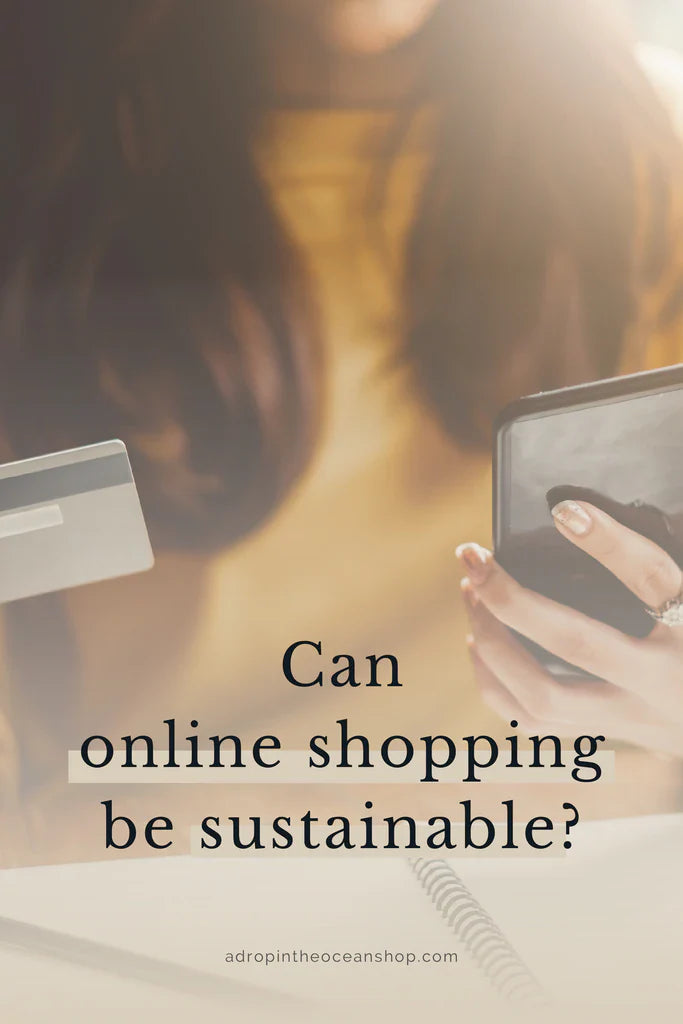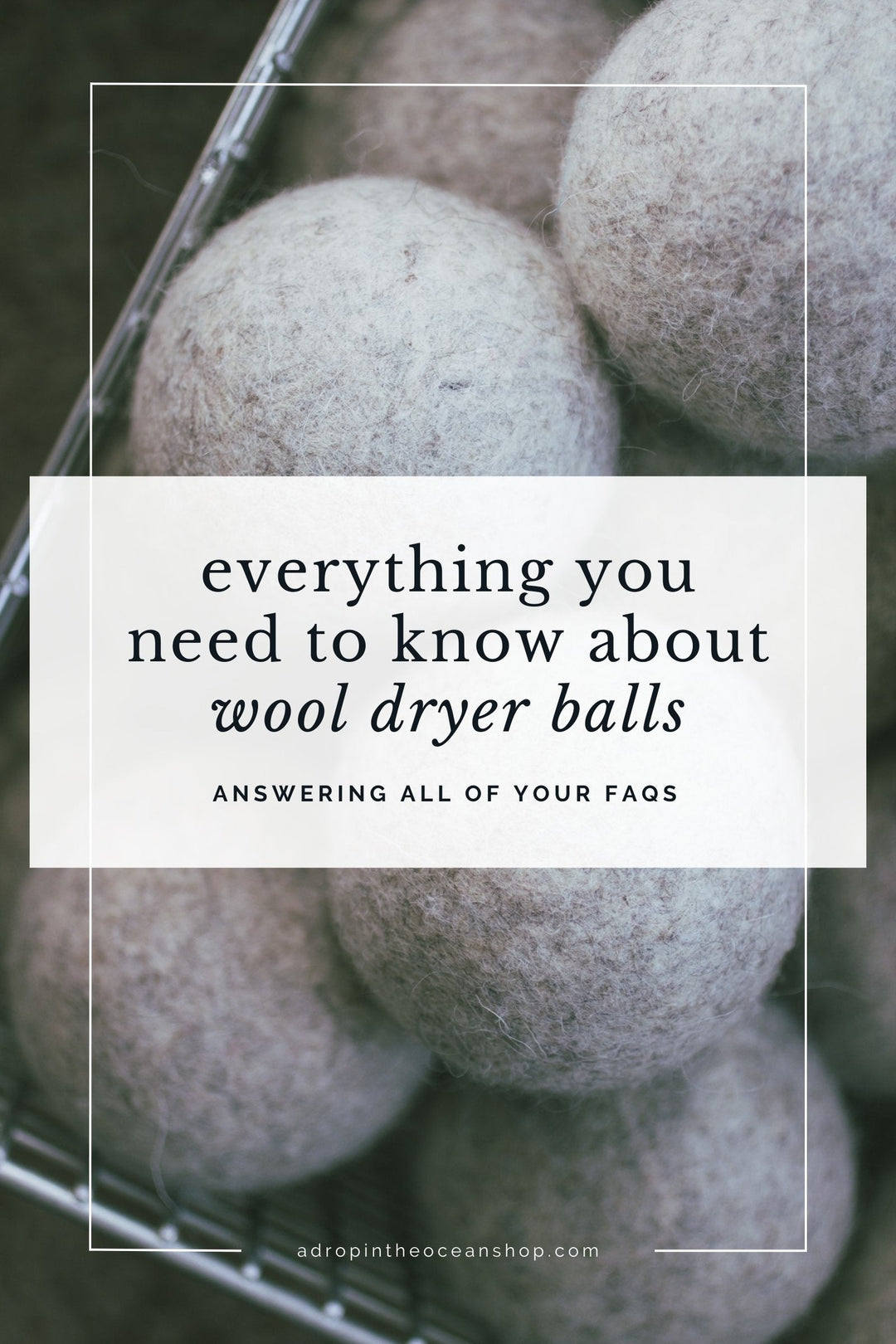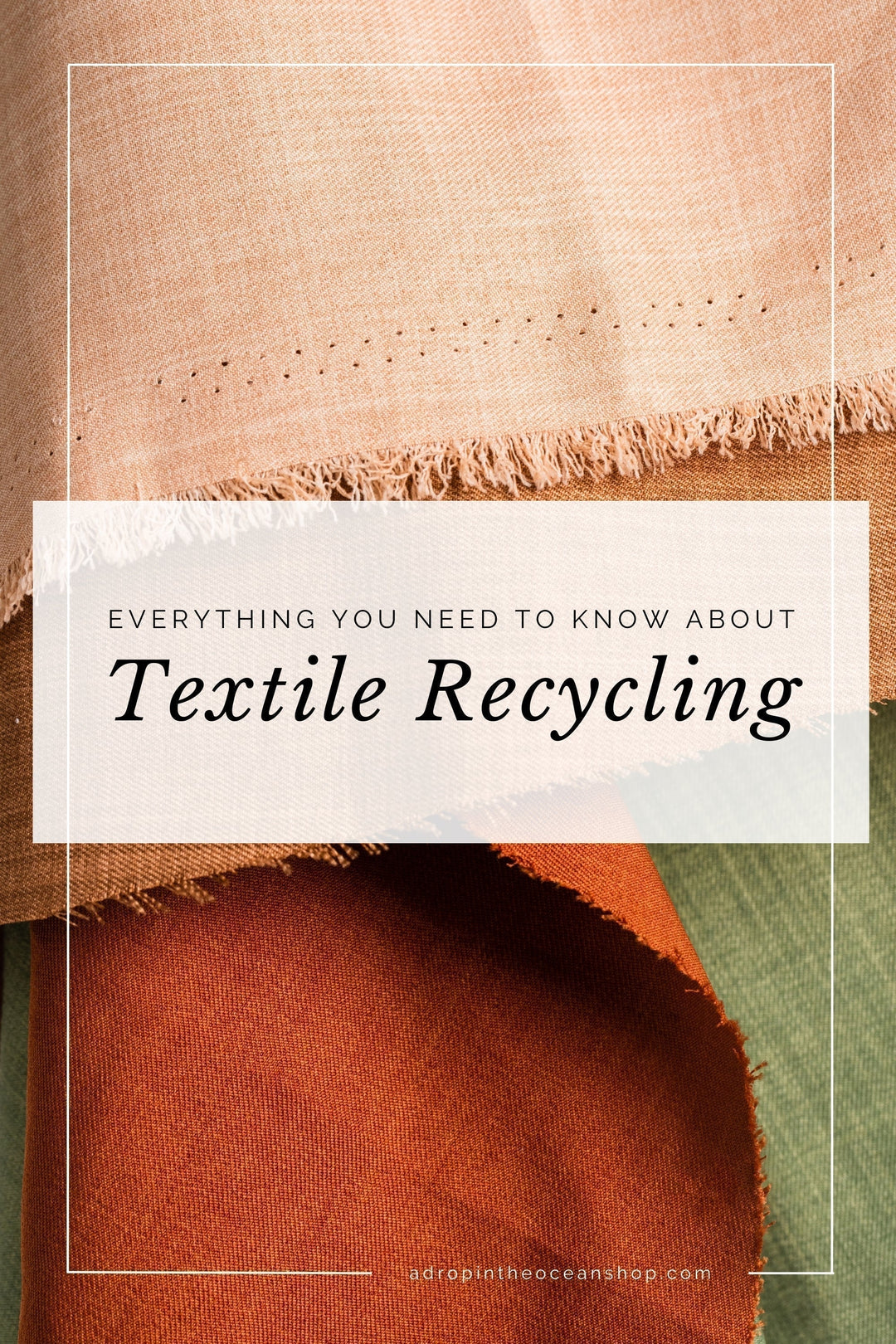What's the Environmental Impact of Online Shopping?

This post first appeared in our weekly Make Waves Mondays email series on March 22, 2021.
Oh hello there, friend!
In the last couple of months, I’ve started getting more and more messages asking if we have a pickup option for local customers.
This is something I’ve thought about - a lot. And right now, we don’t. And that’s highly intentional. But I’m realizing it’s not something I’ve talked about publicly before.
So today I want to take a little deep dive into the environmental impacts of online shopping versus in-person, and how we are optimizing our systems to get you the essentials you need, as fast as possible, as safely as possible, and with the smallest carbon footprint possible.
Because the answer to “which is more sustainable - online or in person?” may surprise you.
Packaging
Okay, let’s start with the obvious first. Packaging.
Online shopping comes with a lot of packaging. We inherently know this. We’ve probably seen our neighborhood recycling bins overflowing with Amazon boxes over the last year.
But what’s the real impact of all that packaging?
According to a 2011 LA Times article reviewing a Carnegie Mellon study, packaging only accounts for 22% of a package’s carbon footprint.
Now, 22% isn’t a small percentage. And, yes, that percentage would be smaller from shopping in-person with our own shopping bags. But...that’s not the end of the story.
What We’re Doing
We are always doing everything we can to minimize our packaging. Learn more about the oh-so-many ways we're keeping things zero waste over on the blog!
Shipping
First and foremost, we reuse boxes whenever we possibly can. Seriously...take a look at our current collected box stash.

This isn’t even all of it.
Most of our boxes come from my Buy Nothing Group. When I’m running low, I’ll put a call out to the group for small boxes and there’s always plenty to go around. I’ll collect them once a week on our local delivery route, and remove all plastic tape and labels. I firmly believe that the consumer shouldn’t be responsible for packaging, so by removing plastic tape and labels, and only using recyclable paper tape and paper labels, we’re making it easy peasy for you to reuse or properly recycle your box.
We also don’t just reuse shipping boxes. My friend Donarius has trained the technicians at the car dealership he works at to save parts boxes. My friend Rob drinks a lot of tea, and I’ll use the empty tea boxes to ship bars of soaps. We’ve used Girl Scout Cookies boxes, Cheez-It boxes...whatever boxes I can get my hands on, we’ll use it to ship orders if we can.
As far as internal packing materials go, I’ve literally never bought packing materials. There’s always SO MUCH available. All of our vendors ship with kraft paper, so I just fold up that paper and reuse it in our shipments. No new paper necessary.
Local Delivery
For local deliveries, we don’t even use boxes. Or bags. Countless studies have shown that paper bags are actually worse for the environment than plastic. The only thing they really have going for them is that they’re biodegradable. And a cotton tote needs to be used 131 times before it has a better carbon footprint than a plastic bag. An organic tote? 20,000 times. (Check out this NPR piece.)
More on the impacts of these different materials in a future blog post.
From the very beginning, I’ve refused to purchase any kind of shopping bags for the shop - even when we were doing in-person pop-up events. The only bags in the shop are our Umutima Bags, handmade in Rwanda and supporting female survivors of violence. That I can get behind.
When we deliver your items locally, we keep as much unpackaged as we can, and when we do need to wrap something for a little added protection from the elements, we use that same reused kraft paper from our vendors. We’ll just use a little bit of jute twine to tie a few things together if we need to, but other than that, there are no new materials used in your delivery.

This one time I decided to get real cutesy with our local delivery notes.
Carbon Emissions
Okay, so, packaging is only a small piece of the puzzle. What’s the carbon footprint of online and in-person shopping, then?
According to that same Carnegie Mellon study, consumer driving accounts for 65% of an item’s footprint when it’s purchased in-store. 65 percent! Umm. What.
As surprising as it may be, delivery trucks are actually way more efficient for delivering packages than for you to pick it up at the store. I couldn’t find these numbers for USPS, but according to UPS in 2010, they use about 0.117 gallons of fuel to deliver one package. An average passenger car would use about 0.636 gallons to pick up that same package. That’s five times more gasoline than delivery!
Imma try REAL HARD not to geek out too much about this next section. I’m a data nerd, in case you don’t know yet :)
A 2013 study from MIT Center for Transportation & Logistics took a DEEP dive into consumer behaviors and how different types of shopping have different environmental impacts. The behaviors ranged from doing everything in-person to doing everything online to everything in between.
They found that a shopper who does everything in person (product research, purchasing, and returns) has a higher carbon footprint than a shopper who does everything online. The exception is when the online shopper opts for expedited shipping. In this case, the online shopper does have a higher footprint than the in-person shopper.
 On the road for some local deliveries!
On the road for some local deliveries!
When they broke shopper behaviors down even further, that’s where I really started to geek out.
A fully in-person shopper (let’s call her Kelly) has a carbon footprint of about 3.1 kilograms of carbon dioxide equivalent.
CO2 equivalent (CO2e) is the standard unit of measure for carbon footprints. It takes all the greenhouse gas emissions and standardizes them to carbon dioxide emissions, rather than breaking them out into carbon dioxide, methane, etc.
About 2.5kg of Kelly’s 3.1kg impact is from her own transportation. That’s about 80% of her impact. Yikes.
Let’s compare that to a fully-online shopper. Let’s call her Joan.
Joan’s footprint is about 1.5kg CO2e, so we’re already at about half the impact of Kelly’s. The majority of their impact is, yes, packaging (about 1kg). Delivery only accounts for about 0.3kg of Joan’s impact, and there’s no consumer transportation impact.
NOW. Where this gets really interesting - and the main point of today’s post - is when we look at an online shopper who opts for a local pickup option instead of delivery. Let’s call her Louise.
Louise’s footprint is about 2.0kg CO2e. So, her footprint is still less than Kelly’s, but more than Joan’s. About 1.5kg (75%) of Louise’s emissions are from her own transportation.
Feeling overwhelmed by numbers? I get it. Here’s a handy-dandy graph from the study 🥰
Kelly = Traditional Shopper | Joan = Cybernaut | Louise = C - Pick Up

What We’re Doing
We’ve put a lot of thought into how we get your orders to you, and we’re constantly evaluating and adjusting.
Shipping
First and foremost, we ship all of our orders through USPS.
USPS delivers to every address in the country. That means that whether or not you have a package coming to you on any given day, they’re driving past your home anyway, and are probably stopping to deliver at least one piece of mail.
By shipping through USPS, we’re not adding any additional trucks on the road, or additional routes. They’re coming to you anyway; we’re just taking advantage of their existing routes, so there’s not really any additional emissions.
There aren’t even additional emissions from getting your package to the post office, because my lovely postal carrier, Bri, picks up your packages from my doorstep on her normal route.
Next, while we don’t specifically offset the emissions from your specific order, we do plant 1 tree for every item sold. Those trees are going to offset about 48 pounds of carbon every year. That’s pretty amazing if you ask me.
PLUS, whenever you check out using the Shop Pay option (aka not a subscription and not PayPal), Shopify itself offsets the emissions from your order.
So, most of our shipments are double-carbon-negative.

Using reused shipping boxes to keep local delivery orders separate.
The items are left on the doorstep and the boxes come home with me again to be used for shipping.
Local Delivery
We are doing absolutely everything we can to keep your local delivery as green as possible.
First, we keep a tight radius (about 10 miles) for our deliveries to make sure we’re not driving long distances for just one or two orders. We also only deliver once a week to maximize our time on the road and minimize our footprint. We optimize our route each week to be the shortest and most efficient route possible, we never leave the car idling, and we offset every single mile we drive.
Those offsets also mean that our local delivery orders are usually triple-carbon-negative.
I’m so proud of how we’ve structured our local deliveries (and shipments), and I’m always looking for new ways to make them even better for you and for our planet.
So...No Local Pickup [For Now]
I’ve thought about this so much, friend. I want all of our EcoWarriors to have access to sustainable essentials as easily as possible, and several have asked for a pickup option.
But when I think about the additional packaging that would be involved to keep orders separated and clearly marked, and how we’d be encouraging EcoWarriors to get out on the road more often, without carbon offsets for those miles, it just doesn’t sit right with me.
If something for A Drop in the Ocean doesn’t feel 100% good for people and planet in my gut, I’m not doing it.
Having said that, it’s something I’m sitting with. Like I said, I want you to have easy access to sustainability, and if adding a pickup option will increase that access...well, it’s something to consider. But I’m not doing it until I can figure out the most sustainable way, that truly feels in alignment with our vision, mission, and values.
I’d love to hear what you think about all of this, friend. Did anything surprise you? Do you have any suggestions for how we could best structure a local pickup system? Let me know in the comments 💙
In two weeks, we’ll chat more about how we can all keep our shopping habits - online and offline - as sustainable as possible.
I hope you have an absolutely wonderful week, my friend. See you again next week.
Sources + Additional Reading:
Dimitri Weideli, MIT Center for Transportation & Logistics: Environmental Analysis of US Online Shopping
The net environmental impact of online shopping, beyond the substitution bias
Honestly Modern: Is Online or In-Store Shopping More Eco-Friendly?
LA Times: Online Shopping: Better for the Environment?
NPR: Are Plastic Bag Bans Garbage?
Polly Barks: Is online shopping eco-friendly?









@S, @Jack – This study (https://www.sciencedirect.com/science/article/abs/pii/S0966692321001113) actually found that taking the bus to run errands emits 7 times more carbon than one stop in a delivery route :) So it’s definitely not just passenger vehicles, and even public transit has a much higher footprint than you’d expect!
I think an important point here is the comparison is being done with people who drive on their own private vehicles. Definitely reflects the majority of people, but thought I had point that out. :)
I see the main component of the analysis that makes a difference is the consumer’s transportation. What type of vehicle does the analysis assume the consumer is driving? I anticipate the results are quite different if the consumer is using an electric vehicle or mass transit instead of an internal combustion engine vehicle running on gasoline or diesel.
I appreciate the eco-friendly packaging options some online stores offer. It’s fantastic to see a commitment to sustainability in the world of online shopping.
I know all these studies and yes, optimized logistics, which is what big carriers focus on, can deliver products more effectively than local shopping options. But, the big problem with online shopping is convenience. People buy way more things they don’t necessarily need of wouldn’t have bought if they need to pick them up. Consumption has risen by more than 60% in the last decade per capita and that by far outweighs the benefits of online shopping. Shopping itself in a capitalistic system is NEVER sustainable. It just can’t be. So buying less or nothing is the only sustainable way.
Leave a comment